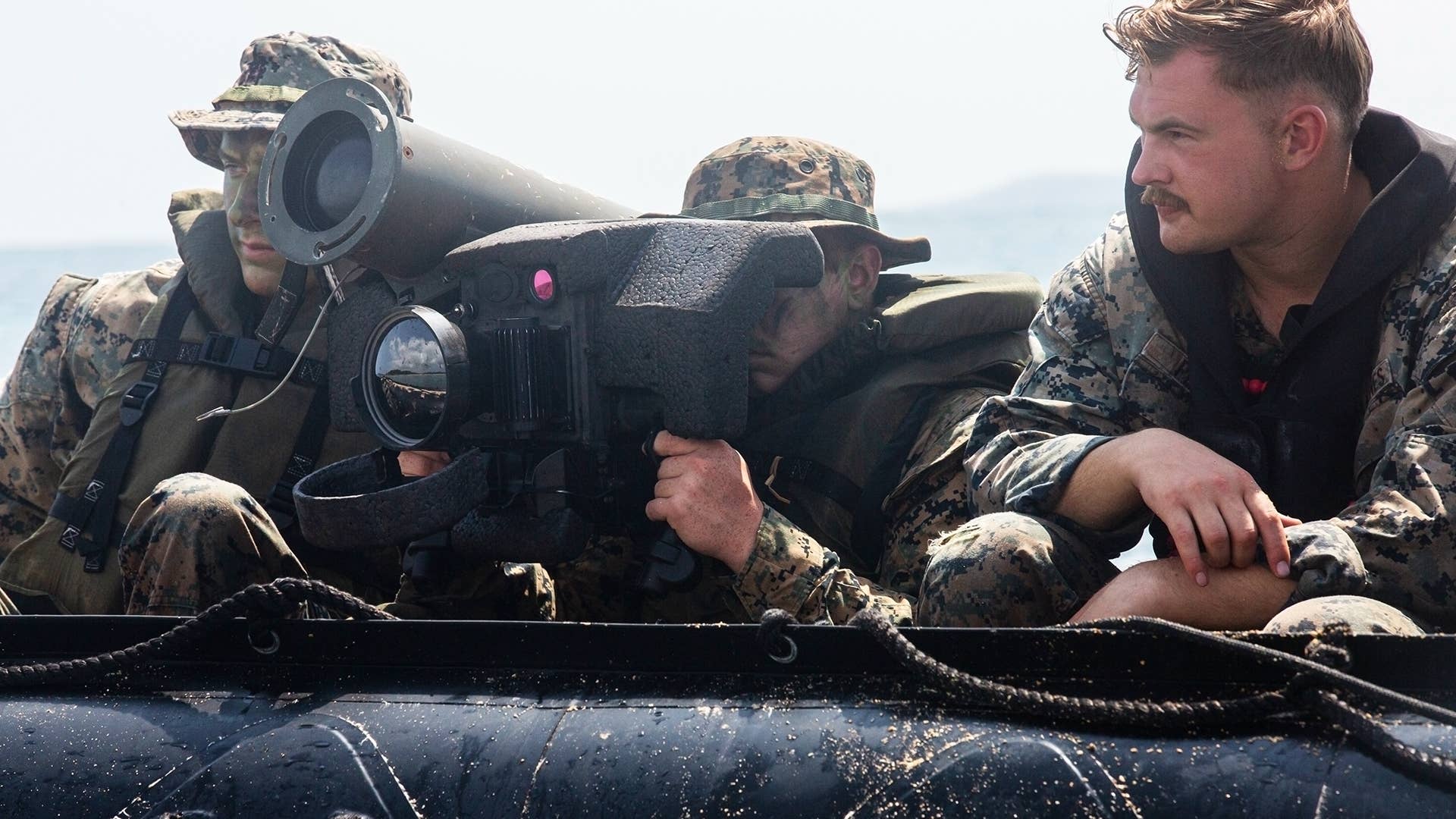Basing U.S. Marines Inside China’s Striking Distance Key to Deterrence
Force Design 2030 will work because it is better for Marines to be forward than to fight their way in, says Lt. Gen. Karsten Heckl.

Not today, Xi.
That was the message delivered Wednesday afternoon by Marine Corps Lt. Gen. Karsten Heckl, the officer in charge of carrying out sweeping changes to the Corps ordered by Commandant Gen. David Berger.
It was part of an effort to sell Berger’s controversial Marine Force Design 2030 initiative. Heckl told a virtual panel held by the Center for International and Strategic Studies and the U.S. Naval Institute that the objective was to keep a stand-in force of Marines – currently the III Marine Expeditionary Force headquartered in Okinawa, Japan – forward inside the range of Chinese fires. That, said Heckl, will make the communist nation think twice about taking aggressive action in the Pacific.
Being forward inside the weapons engagement zone, with allies and partners, reassuring them every day, by walking the real estate with them, that is deterrence,” Heckl said. “And that is the true value proposition of force design- to simply make the leadership within the CCP wake up in the morning and go, ‘today just ain’t it,’ right?”
The Force Design 2030 initiative, officially launched on March 23, 2020, aims to fundamentally change the way Marines operate after 20 years of land-focused warfare in Afghanistan and Iraq.
It calls for addressing what the current Marine leadership says are shortfalls in a variety of increasingly important capabilities, including expeditionary long-range precision fires; medium to long-range air defense systems; short-range (point defense) air defense systems; high-endurance, long-range unmanned systems with intelligence, surveillance, and reconnaissance, electronic warfare, and lethal strike capabilities. In addition, the initiative seeks “disruptive and less-lethal capabilities appropriate for countering malign activity by actors pursuing maritime ‘gray zone’ strategies.”
The idea is to redesign the force to focus once again on naval expeditionary warfare “and to better align itself with the National Defense Strategy, in particular, its focus on strategically competing with China and Russia,” according to a 2021 Congressional Research Service report.
The Force Design initiative is informed by two operational concepts: Littoral Operations in a Contested Environment and Expeditionary Advanced Base Operations (EABO).
Littoral Operations In a Contested Environment is a concept to allow U.S. maritime forces to operate in contested areas, where the adversary operates closer to home, in a sensor-rich environment with ample long-range fires to counter U.S. naval power.
At its core, EABO involves relatively small groups of Marines quickly establishing bases of operation in forward areas, especially on small islands. This concept of distributed operations also envisions them being able to then rapidly reposition themselves, as necessary. The purpose is to use these flexible, responsive ground forces to help control littoral areas, and even surrounding “seaspaces,” to deter opponents in situations short of an actual conflict, and then, if that fails, be well-positioned to engage enemy forces.
To make these concepts work, the Marines intend to eliminate or reduce several types of units and their corresponding military occupational specialities, including tank, bridging and law enforcement.
The Marines have ditched tanks entirely, with the plan to rely on the Army if needed.
“We have sufficient evidence to conclude that this capability, despite its long and honorable history in the wars of the past, is operationally unsuitable for our highest-priority challenges in the future,” Berger wrote in his initial Force Design document. “Heavy ground armor capability will continue to be provided by the U.S. Army.”
The Marines are also looking to deactivate several aviation squadrons – tilt rotor and rotary wing.
In addition, the Marines are planning to reduce the number of F-35B and C aircraft in each squadron from 16 to 10, and replace its fleet of RQ-21 Blackjack drones with larger and smaller remotely piloted aircraft.
The Marines also plan to reorganize higher echelon Marine formations and get smaller—reducing forces by 12,000 personnel by 2030. That reorganization of core Marine units includes the creation of these EABO-focused formations called Marine Littoral Regiments.
“We’ve recently stood up the 3rd Marine Littoral Regiment,” said Heckl. “It should go out to sea sometime next year. And we’re looking forward to all the experimentation with that and how it’s going to inform Force Design.”
The plan has drawn sweeping criticism, particularly from former Marine leaders, such as this one, titled “The Marine Corps’ plan to redesign the force will only end up breaking it.”
“After a detailed examination of Force Design 2030 and supporting documents including the Tentative Manual for Expeditionary Advanced Based Operations and the concept for “Stand-in Forces” we can only conclude that Marine Corps leaders are moving to create a force that will be incapable of meeting the Congressional requirement to provide fleet marine forces with effective combined arms,” wrote retired Marine Lt. Gen. Paul K. Van Riper in a scathing series of editorials on the subject published by our sister publication, Task & Purpose.
During the hour-long talk, moderated by Seth Jones, Heckl took some of the blame for the criticism.
“Let me start off with putting some of the responsibility for that where it belongs; probably on me for not doing an articulate enough job, which I’ve been doing a lot lately, of explaining Force Design,” he said.
Heckl explained that U.S. military policy, like the National Defense Strategy developed in 2018 under then-Defense Secretary James Mattis, is what is driving the Force Design initiative.
“We always, always build to the worst-case scenario, which in this case clearly is China,” he said, pointing out that in addition to military might, they have a great global economic influence.
“So this is much worse than the 70-year Cold War with the Soviet Union,” he said.
The Marine Air-Ground Task Force, or MAGTF, “still exists,” he said. “All the modernization that we’re doing with Force Design is going to make the rest of the MAGTF that much better.”
The MAGTF is the primary organization Marines use to accomplish missions across the range of military operations. The most common iteration of the MAGTF is the Marine Expeditionary Unit (MEU) stationed afloat on board the ships of a Navy Amphibious Ready Group (ARG).
“A MAGTF can be anything based on task and purpose, the mission given,” said Heckl. “The real ability of a Marine Air-Ground Task Force to project is off of amphibious ships, where we can bring the full weight of a Marine Air-Ground Task Force, flight deck, fifth-gen fighters, well deck, 2,500 bloodthirsty Marines, right?”
That stand-in force – in this case, the III Marine Expeditionary Force – makes all the difference, said Heckl.
“Presence matters,” said Heckl. “They’re there. They live, eat, train every day inside the PRC’s [People’s Republic of China] weapons engagement zone. You can even be a JV student of history and know that if you’re not there when a conflict begins or when a crisis begins, you’re going to have problems, right? If you’re going to have to fight your way in, that’s not a good place to begin, right?”
The value of a stand-in force, with “very small signature management, is in everything we do with Force Design,” Heckl said, adding that “a small, maneuverable, very lethal, but forward, stand-in” force is the key to success.
“Being there is – this is me talking – 90 percent of the fight, you know,” he said. “So a real challenge for me as a MEF commander in San Diego, the biggest MEF in the Marine Corps, was the 7,000-mile physics problem I had.”
To keep future Marine forces supplied and mobile, Heckl pointed to Force Design 2030’s call for Light Amphibious Warship (LAW).
“The light amphibious warship is an example of what would be a major contributor to logistics,” said Heckl. “So as indication and warnings are coming in, we would use the LAW to provide a quick dump of sustainment supplies and then back out as things escalate. What we should be focusing our sustainment efforts on are lethality – rearming and keeping Marines so that they can perform the missions they’re there for.”
Heckl also scoffed at criticism that the Marines are not purchasing enough remotely operated systems. The Corps has already ditched its fleet of RQ-21 Blackjack drones in favor of other unmanned platforms, including the MQ-9 Reaper. You can read a full report on those changes here.
“We’re going to have three MQ-9 squadrons,” he said. “We’ve got one fully up and running now doing missions all the time. We are very aggressively pursuing not just UAVs, but all things unmanned.”
That, he said, includes both on and under the waves.
“To be that fleet Marine force in support of a numbered fleet and the joint force, we have to be able to sense and make sense in all domains, to include sub,” he said. “So we’re pursuing avenues on all of that.”
But, he cautioned, with the rapid advance of technology, the Marine Corps has to “be careful of programs of record, right, because by the time you get one inked there is a new technology. So we need to stay nimble and agile so that we can maximize the technology and keep up with it.”
Heckl likened the Chinese military buildup on atolls in the South China Sea with Russia’s annexation of Crimea in 2014 as additional examples of why the Force Design initiative makes sense despite the withering complaints.
Both of those situations, he said, fall under the concept of “gray-zone” warfare, actions that fall below the threshold of all-out combat but which could encompass a range of activities, including cyberattacks, assassinations, or occupation by unofficial militias.
As a result, having a stand-in force of Marines will only be more important, he said.
“I would say the important thing with gray-zone activity if you have to be there,” he said. “In order to counter malign activity/coercive behavior, you have to be there – again, to the point of standing forces.”
Berger’s annual update is due out next week, said Heckl.
It remains to be seen whether that will quiet any of the critics or just add more fuel to their fire.
Contact the author: [email protected]
" Conservative News Daily does not always share or support the views and opinions expressed here; they are just those of the writer."





